If you read the last blog post, you’ll note that I hadn’t yet found information about the Giant Toad that hopped in front of us as fellow Texas Master Naturalist Eileen Mattei and I traversed Lyford’s Hilltop Gardens.
Recall, that big dude measured some five inches from snout to bum on my iNaturalist Nature Tracker ruler.

A Texas Parks and Wildlife Department toad expert has since identified the toad as a cane toad (Rhinella marina).
According to www.worldherps.com, “The genus Rhinella was split from Bufo by Frost et al in 2006, then redefined by Chaparro et al in 2007 to include Rhinella marina. In 2016 the populations of Rhinella marina west of the Andes were split out by Acevedo et al into the new species Rhinella horribilis.”
Here’s some interesting info on the cane toad, also known as giant toad, neo-tropical toad or marine toad. It is a large land toad native in the Valley, south to Mexico, and into Central and South America. It’s the largest toad in the world.
Cane toads are in the Bufonidae family, and are known as true toads.
True toad characteristics include having warty skin, plump bodies and short legs. They have no teeth or breastbone. Most significantly, members of this family have a pair of parotoid glands on the back of their heads that contain toxins.
The cane toad can reach to eight inches in length but more likely to be closer to seven inches in America. Still, in toad size, that’s huge.
Toads are measured from tip of snout to base of tail bone. Lizards also are measured thusly. It is called snout-vent length (SVL). The tail on a lizard is not included in the measurement nor the stretched out legs of a toad or frog.
In the wild, cane toads are opportunistic carnivores. They eat a wide variety of invertebrates and vertebrates, including insects, reptiles, rodents, other frogs and smaller R. marina toads. They also eat carrion and plants. They hunt by sight or by using their sense of smell.
The cane toad living in urban areas will eat pet food that’s been left outdoors and household garbage, including carrot peelings, lettuce, cooked rice, rotting avocados, and feces.
They can live 10 or more years.
Here’s a myth debunked: The warts on a toad aren’t warts. The rough and bumpy skin, scientists believe, helps camouflage them from predators. However, a toad’s parotoid gland is something of which to be cautious, especially on the cane toad.
The cane toad produces the strongest poison of all toads. Their large parotoid glands extend from just behind each eye and reach far down the sides of its body. The gland secretes a bufotoxin, which acts as neurotoxins, and can kill its predators and irritate human skin. Cane toads can shoot the poison three feet and more.
If you hear a low-pitched, staccato trill sounding like a distant tractor, you might be listening to this interesting giant of a toad.
The toad was a great find, I thought, and if you happen upon one in your travels, look but don’t touch.
Leaving the world of toads, this week’s adventure with freelance travel writer and Texas Master Naturalist Eileen Mattei, took us to the Palo Alto Battlefield National Historical Park.
Summer is a great time to play tourist in the outdoors here in the deepest part of Texas because most people — other than writers and photographers — are elsewhere avoiding the hot sun and humidity — therefore, we’ve had the sites nearly to ourselves this scorching July.
At the battlegrounds, the first colorful thing to capture my attention was about 20 feet out from the headquarters building and plop in the middle of the boardwalk.
Something had been in the prickly pear tunas causing the animal to have a little bit too much fiber in its diet. Coyote scat, one of the rangers identified for us later.
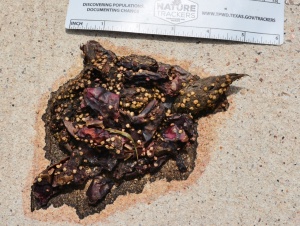
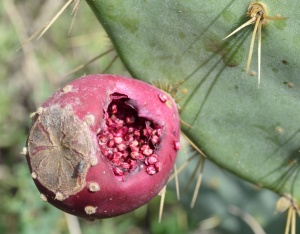
Shortly after that interesting find, Eileen pointed out a three-foot square area of something I certainly never thought I’d be adding to my photo collection — but here it is — you’re the first to view this amazing shot — nilgai scat. I know! Fun, what?
Nilgai apparently subscribe to the community style latrine.

Animal functions aside, we continued along the boardwalk heading into the battlegrounds when my attention was caught by a cinnamon-colored, triple-spiral-pasta-like-multi-directional-vegetative object sticking out from the leaf structure of an 18-inch tall tree.

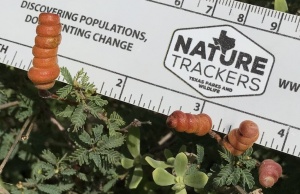
“Screwbean mesquite!” I knew it instantly. Something I thought I would only ever read about. Here we were, not even five minutes into this adventure, and I’d already seen three things to fascinate me.
Mesquite is a common name for several plants in the genus Prosopis which contains more than 40 species of small leguminous trees.
Texas is home to three such mesquite; ours in the Valley is typically the honey mesquite (Prosopis glandulosa). The other two are screwbean mesquite (Prosopis pubescens), native to southern California; and velvet mesquite (Prosopis velutina), a southern Arizona native.
Read more about these three mesquites at: https://www.desertusa.com/flora/mesquite-tree.html#ixzz5LyuyMOD4
The national parks Resource Manager, Archeologist Rolando Garza, has made a concerted effort to replace the battlefield flora with its rightful vegetation and has done a remarkable job re-vegetating with Gulf Cordgras (Spartina spartinae).
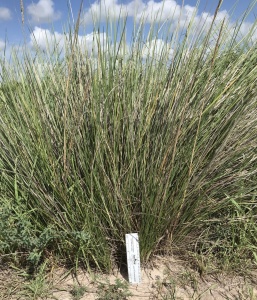

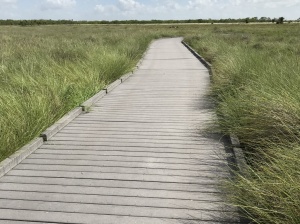
There is a lot of interesting plant life along the boardwalk and trails through the battlegrounds well worth a special road trip, even on a hot summer’s day — bring water and bug spray, a hat if you like, but dress for staying cool — shorts, sandals will do as the paths are accommodating for the most casual of tourist.
Because of the recent rains, large land snails were out in force and choosing a variety of plants seemingly without discretion.
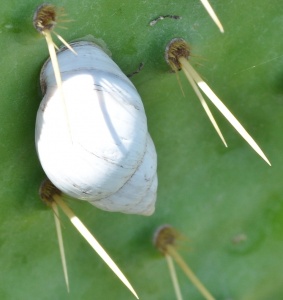
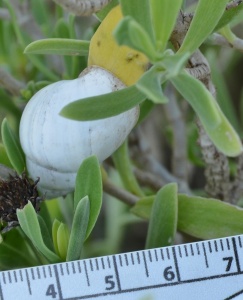
The rains also had filled topographic depressions. A black-necked stilt was sitting a nest at the shore of the impromptu resaca while its mate did an amazing pantomime to keep us away. Close by, a busy killdeer showed off its aerobatics catching tasty bugs.
Tropical waterlilies dotted the bog adjacent to the raised boardwalk where plant growth and algae was so thick it was hard to see the water.
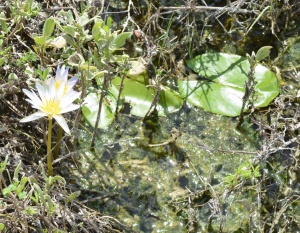
Airy sea lavender (Limonium carolinianum) like purple neon fairy wings met us as we rounded the last turn, arriving back at the air-conditioned visitor’s building where I was able to add to my laminated-folding-pocket-guide collection from the gift store.
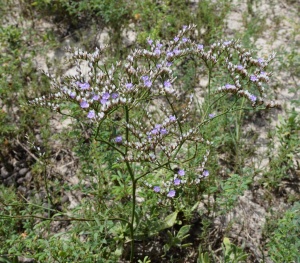
What keeps my interest is discovering plants and other forms of native – and introduced – Valley wildlife that I haven’t previously come across — whether it be plant, scat, tracks or other mysterious signs.
My “collection” lies in the labeled photographs on my computer and in numerous PowerPoint presentations that I give to local clubs and organizations around the Valley.